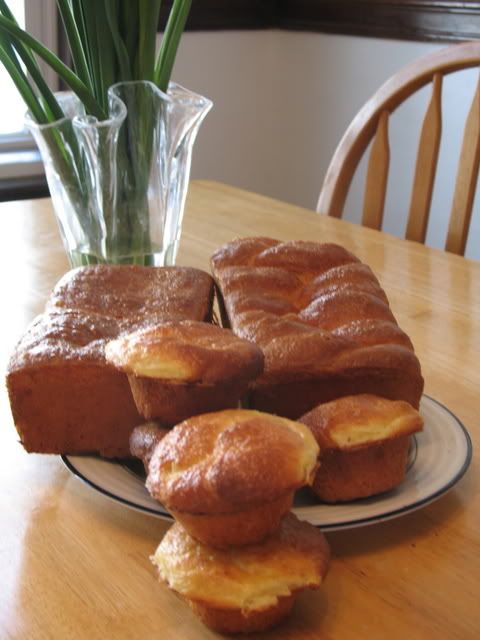It hasn't been a snowy winter, but (an unnervingly warm first half of January aside) it has been a cold winter. Thankfully, spring has finally arrived. Our New England canopy is finally greenish again, and the temperature has been creeping toward, occasionally even attaining, 70 degrees. Which can only mean one thing.
Time to bake burger buns.
But of course, I had a lot more baking than that in mind. Plus, thanks to a post by TheGreenBaker which led me to revisit Mike Avery's Stretch and Fold video and lesson, I decided to try not kneading anything I worked on this weekend.
It worked beautifully and is easily the biggest breakthrough for my baking technique in many, many months. Knowing that I can just mix any bread in a matter of minutes and then only need to pay attention to it for 3-4 minutes every hour or so is hugely liberating. With a 3-year-old, finding 3 minutes is no big deal -- finding 20-30 is a very big deal indeed.

The first bread I made this weekend was Desem, as we were having friends over for dinner. The menu I'd planned was relatively simple. Asparagus with lemon butter, golden cheddar soup (a delicious, easy soup from The Moosewood Restaurant Cooks at Home with potato, carrots, yellow squash, onion, garlic, buttermilk and ... oh yeah ... cheddar) and carrot and avocado salad.
Basically, I thought these foods would go well with the bread I wanted to bake (surely, I'm not the only one here who plans menus in this bass-ackwards fashion ....).
Here's how I made it:
- Whole wheat bread flour: 100%
- Water: 90%
- Salt: 2%
- Starter: 30% of the flour was prefermented at 60% hydration
Ingredients:
- Whole wheat flour: 350 grams
- Water: 360 grams
- Salt: 10 grams
- Starter: 240 grams
First, I tore up the starter into small chunks, poured the water over it and mushed it up with my fingers. I then let it soak for about 10 minutes before I added the flour and salt, which had already been mixed together. A minute or so of mixing with the dough whisk, and I covered the bowl with a plate to rest at room temperature for an hour.
After an hour, I removed the dough, which was still very rough, and flattened it out gently, looking for thick spots with my fingers. When I found them (and there weren't many), I mashed them real good with the palm of my hand. I then did one
stretch and fold and let it rest again. I did two more folds over the next three hours, before I shaped it.
Here's where I owe a huge thank you to all the kind folks who gave me advice on how to avoid the
sticky sticky arrgggh sensation I'd come to know so well. It turns out Bill Wraith's advice was really key, for me, anyway. The dough was pretty wet (though not as wet as the
100% hydration high-extraction flour ciabattas Bill regularly wrangles with - now THAT'S amazing), so I was concerned that I'd get a stringy, gluey, sticky mess when I tried to turn it out of the proofing basket and onto the peel. But Bill had suggested dusting the loaf
before placing it in the well-floured banneton. I did, and it worked. I used a 50-50 mix of white rice flour and whole wheat flour for dusting and, I'm happy to say, the loaf popped right out. Amazing. Thanks Bill, and everyone else.
I turned the dough out onto parchment on my peel, and then loaded it directly onto a hot stone at 460 degress F, which I promptly covered with the top half of my
cloche. After 30 minutes, I uncovered it and let it bake for another 20 minutes.

The crumb was more open than it was a 85%, but still not as open as the beauties that
Mountaindog and
Jane pulled from their ovens. I'm wondering whether it's my dough handling? Perhaps I'm being too rough shaping the dough into a boule? Mountaindog, could you describe (or even better, video) how you shape your dough? I'm beginning to think that's the key to how you get such a beautiful crumb structure.
Nevertheless, I was the only one who was a bit disappointed. The flavor was everything I could have hoped for from a Desem loaf. One of our friends thought it had to have some rye in it.
On Sunday, I made
sourdough waffles that came out ... very strange. The salt apparently didn't blend into the dough, which resulted in waffles that were mostly bland, except for pockets of pretzel-like saltiness. Unappealing, to say the least. I'm not sure what I did wrong, as I thought I'd blended the salt well. Guess I didn't. Anyone else ever have this problem? Pretzel-waffles are a concoction I can't recommend to anyone.
After
church, I took a trip to
Debra's Natural Gourmet in Concord to pick up another 50 lb bag of hard red spring wheat. It's a bit of a hike, but worth it - it's the only place I can get big bags of wheat berries in Boston that I know of, and it's relatively cheap. Just less than 50 cents a pound for organic berries.
So, in the afternoon, I made Kaiser rolls (gonna grill turkey burgers tomorrow night - yum) and some sourdough sandwich bread.
First though, we had to have dinner. Earlier in the day, I'd pulled a
sourdough pizza doughball from the freezer and put it in the fridge to thaw. Around 4pm, I put it on the counter and, after a trip to the park with Iris, came back to make the sauce, grate the cheese, chop the toppings and make the pizza. I was a bit concerned, since this doughball had been in the freezer for one month, but it turned out well, as you can see below.

.
I'm not sure why the cheese bubbled up to cover the toppings (roasted bell peppers, sliced turkey sausage and black olives) but it tasted fine, anyway. I used a new brand of feta, so maybe that's it?

The whole wheat Kaiser rolls turned out really well, though I made them wetter than I'd intended because I didn't compensate adequately for the eggs. I didn't do the Kaiser roll fold, though - I just tied them in an knot. My daughter wanted me to play dominoes (the knock-down kind, not the boardgame), so I didn't have time for anything really fancy.
Last, the whole wheat sourdough sandwich dough.

I used the stretch-and-fold method with both the rolls and the sandwich bread, and, I've got to say, the dough was at least as well developed as it is when I knead, and may have been even better. The only change I made to the recipe was to melt the butter for easy incorporation. From now on, I'll be much less kneady guy.
I thought I'd leave you with one more photo, just to prove that I don't do
all the baking in the house. While I went to get grains (btw, I bought 6 lbs of spelt berries while I was there. I can't WAIT to try them out!), Aurora and Iris made brownies!

I used to lick the spoon in exactly the same way when my Mom made brownies.
Heck, when no one's looking, I still do.



















 Sourdough Pagnotta (1)
Sourdough Pagnotta (1) Sourdough Pagnotta (2)
Sourdough Pagnotta (2) Sourdough Pagnotta (3)
Sourdough Pagnotta (3)

 .
. 

